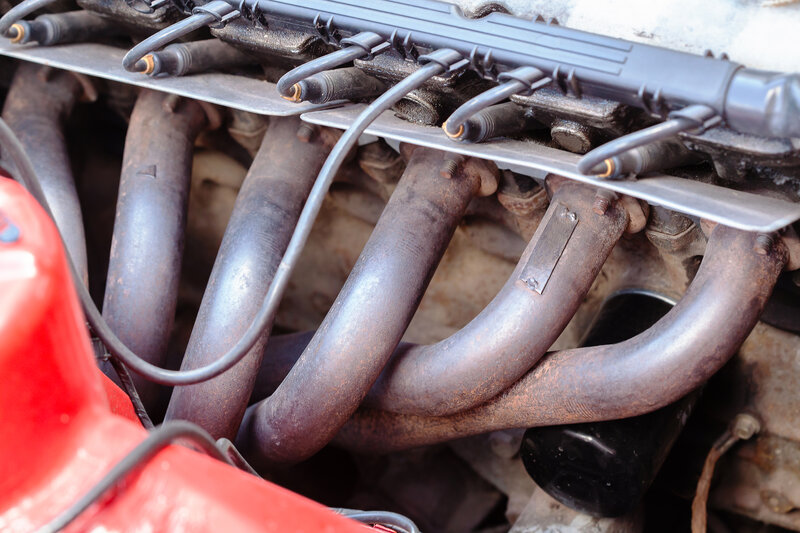
Regardless of whether you have a car or truck and its make or model, it has an exhaust manifold to direct exhaust from the engine to the tailpipe. It’s very common for this part to develop leaks thanks to constant exposure to high heat. Understand the most common exhaust manifold leak symptoms and get the problem repaired as soon as possible by a mobile mechanic in the Bay Area to avoid more significant and dangerous car problems.
The exhaust manifold connects your vehicle’s engine to the exhaust pipe, directing exhaust and heat away from the engine so the internal components don’t overheat and fail prematurely. The part also helps maintain steady pressure inside the engine to ensure optimal performance.
The most common reason for a leak is the failure of the manifold gaskets, the part between the individual cylinder head and manifold, which can develop broken or bad seals. The manifold itself can also crack or warp due to exposure to extreme heat over time. It’s also possible for the bolts holding the manifold in place to loosen or fall out, causing a leak; this issue is most likely a manufacturing defect rather than something caused by the vehicle’s age or condition.
Regardless of the cause, when the exhaust manifold leaks, it can allow toxic carbon monoxide to enter the cabin, as the exhaust doesn’t move from the engine to the tailpipe as it should. The leak will only get worse in time and, without repair, can cause the catalytic converter to fail, which is a more substantial and expensive problem.
When you know the symptoms of an exhaust manifold leak, the issue is easier to identify and fix before it causes additional damage.
The most common and obvious of the exhaust manifold leak symptoms is a pronounced ticking noise when you turn on the vehicle. A leaking manifold will also cause this sound, which is a rapid clicking or tapping noise that tends to be louder when you first fire up the engine. Sometimes the noise goes away while you drive because the manifold expands as it warms up, blocking the leak.
A leaking exhaust manifold can also cause the engine to make a hissing sound when the vehicle idles or during acceleration. The hissing comes from compressed air escaping from a cracked manifold or head pipe.
A leak in the exhaust system can cause the check engine light to come on. When exhaust leaks, the oxygen sensor thinks that the engine is running too lean, meaning there’s too much air and not enough fuel in the mixture. This state triggers the check engine light to come on.
If the vehicle starts or runs rough or has performance issues like poor acceleration, an exhaust leak could be the cause. You may notice a significant decrease in engine performance and an increase in fuel consumption. This problem can occur when the oxygen sensor’s readings trigger the onboard computer to make the air-fuel mixture richer by adding more fuel, which causes the gas gauge to go down more quickly and the engine to run roughly.
When smoke with a bluish tint comes from the exhaust pipe, there’s an engine issue that’s causing the oil to burn. While engines burn oil for several reasons, including damage to the pistons, piston rings, and cylinders, any problem with the internal engine components can create issues. If you see blue smoke, get an immediate repair to prevent catastrophic engine failure.
One of the most surefire exhaust manifold leak symptoms is an unpleasant and strong exhaust odor inside the vehicle while the car is running. Keep in mind that carbon monoxide is odorless, but the exhaust isn’t, so if you smell anything at all, keep the windows open and avoid driving if possible until you can get the vehicle to a mechanic.
If you’re familiar with your vehicle’s engine and know what to look for, you may be able to identify signs of damage and manifold leak symptoms just by popping the hood and examining the engine block. It’s typically easy to see where extreme heat causes the bolts holding the manifold onto the head to weaken and fall out or for a warped manifold to break the studs.
You might also notice the consequences of high heat under the hood when there is an exhaust manifold leak. Sometimes cracks are visible, or you will see soot and blackened areas around the leak. You might also notice other damage, like melted wires or other components.
Unfortunately, exhaust manifold leak symptoms are similar to other common exhaust leaks, so the only way to confirm the issue is to inspect the part for damage. In most cases, the knocking or tapping sound in the engine indicates that the manifold is the issue, as are visible cues like visible warping or cracking.
Otherwise, a mechanic will need to remove the manifold cover to investigate and determine whether the part has a leak and, if so, evaluate the extent of the damage. In most cases, the problem is repairable if caught in time. Ignoring the signs will only worsen the leaks and potentially cause engine failure or an engine fire if the header wrap gets loose and burns through.
If your vehicle isn’t running as it should and you can check off all the exhaust manifold leak symptoms, get in touch with All Bay Diesel for fast, reliable diesel and mobile truck repairs in the San Francisco Bay Area. From battery and engine problems to diesel exhaust fluid services, these experienced auto technicians will keep your vehicle running safely and in top condition.
Get the help you need by calling (925) 522-1780.